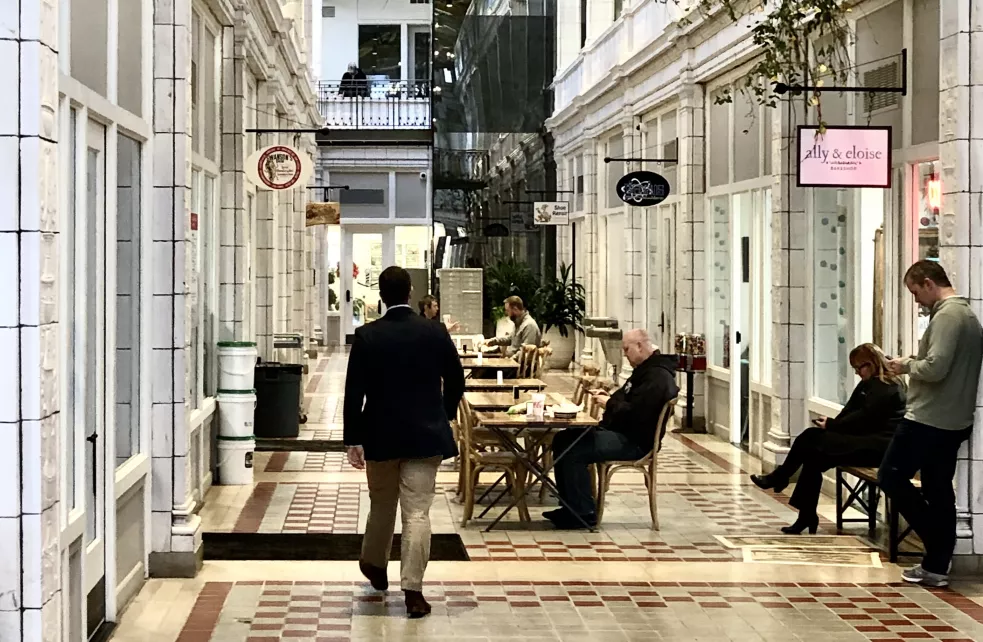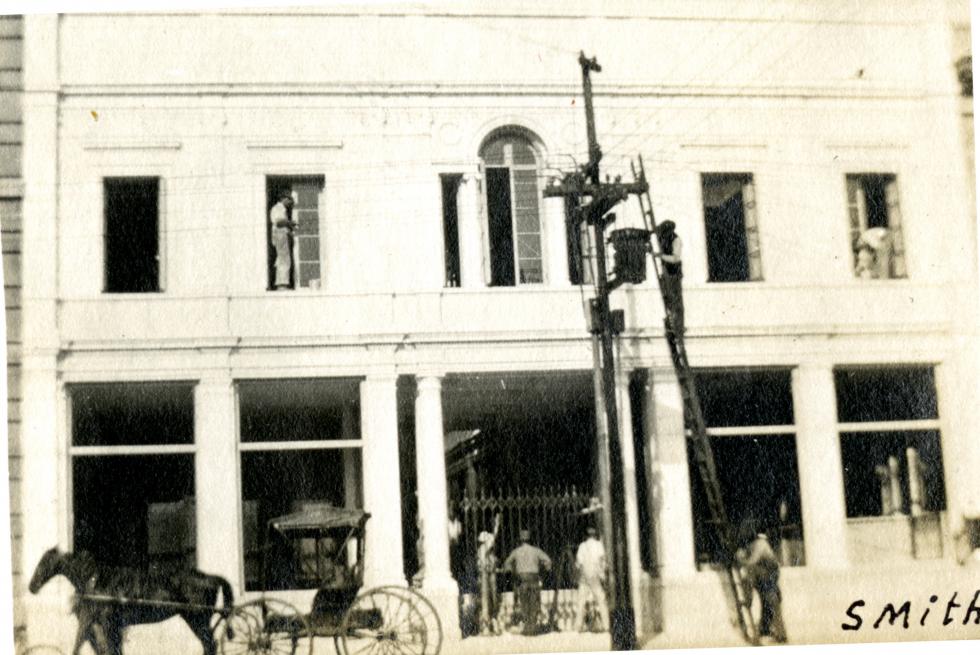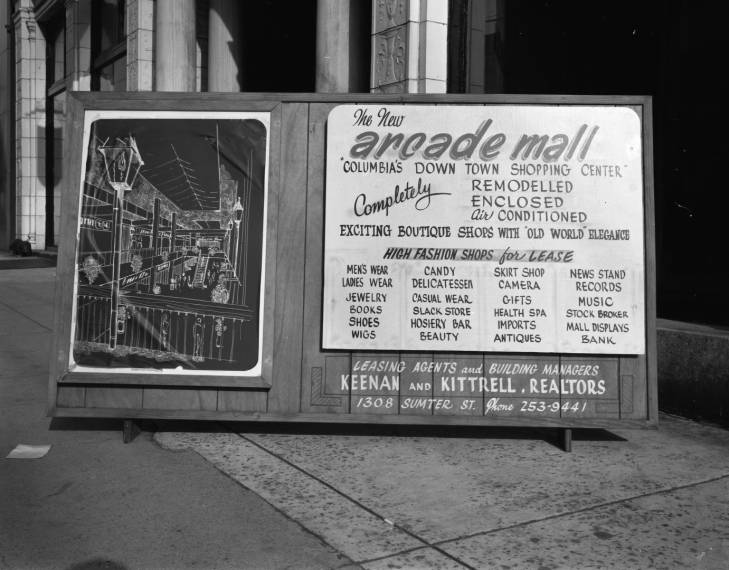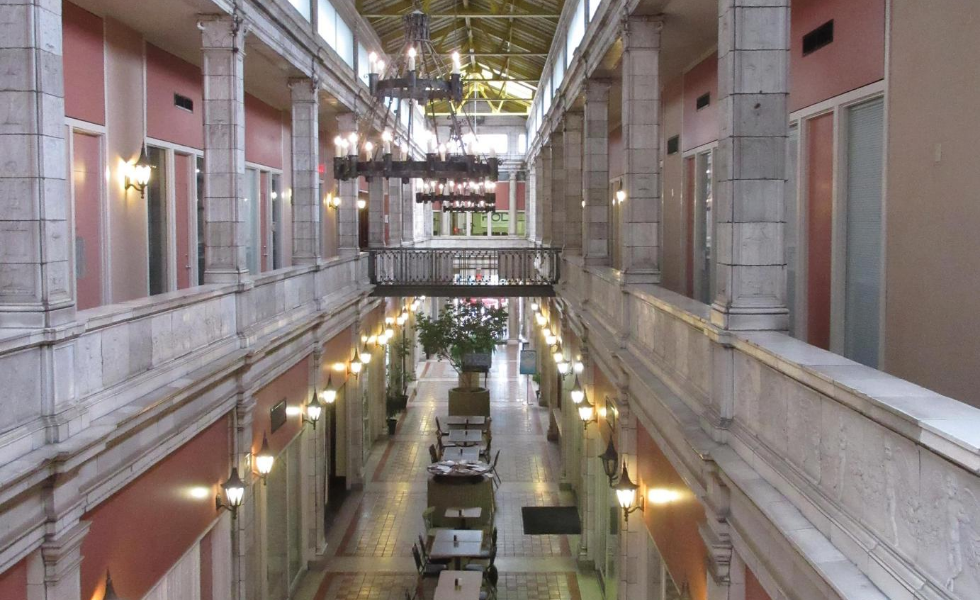2020 Preservation Award Winner: The Arcade Building
Sunday, August 30th 2020

The Arcade Building is once again a downtown destination. Image courtesy of Peach Properties
Each year, Historic Columbia presents Preservation Awards to celebrate the accomplishments of local property owners; professionals in the fields of architecture, construction and design; and leaders who champion preservation as an opportunity to support the Midlands’ economy and culture. These awards are given in the areas of Preservation Leadership, Preservation/Restoration, Adaptive Use and New Construction in a Historic Context.
The Arcade Building
1332 Main Street/1208 Washington
Preservation/Restoration
Architect: Joel McCreary
Contractor: Sacon

Visionaries intent on creating a vital center of diversified commerce stand behind Columbia’s Equitable Arcade Mall—both at the property’s completion in 1912 and in 2015, after more than a century of use by numerous tenants prompted an unprecedented restoration initiative. The landmark’s genesis lay in 1910 with the Equitable Real Estate Company board of directors whose members—banker Edwin Wales Robertson, City Development Company co-founders Gilbert Milo Berry and W.D. Melton, cotton factor C.W. Heath, Edward Ehrlich, George Baker and Charles Ellis, ranked among the city’s most successful early-20th century businessmen, landowners, and social leaders—sought to capitalize on a wave of extensive urban prosperity and growth.
Two years later, local contractor John J. Cane completed New York architect James Brite’s striking design. Boasting a steel skeleton clad in decorative terracotta, Indiana limestone, granite, and marble, the two-story building proved both attractive and highly functional. At is debut in May 1912, shortly after the Titanic had made its ill-fated maiden voyage a month before, the $150,000, L-shaped, Renaissance Revival style property became an instant destination. While the ground floor accomodated dozens of stores and the second story housed 37 offices, the basement level offered storage space and iceboxes. With its double-street exposure offering access to both Main and Washington streets—the structure became a genuinely unique experience in Columbia and one only three similar type malls in the South at that time.
Tenancy within the mall fluctuated throughout the twentieth century. Early businesses included Henry Abell’s Shoes, The Kiddie Shop (catering to high-end children’s wear), Mrs. McMaster’s Tea Shop, the Seaboard Ticket Office, Colonial Life and several brokers. Later, engineering firms, other insurance agencies, soda fountains, styling salons, contractor offices, and further real estate and investment companies operated out of the desirable location. With the suburbanization of Columbia during the mid-20th century large shopping malls located outside the city’s former commercial core surpassed the Arcade Mall and other downtown shops and department stores in popularity. During the decades, however, certain businesses, such as the Arcade Barber Shop, which operated from 1930 until 1970 remained fixtures for generations of patrons.

In 1970, then new-owner M. Berley Kittrell made big plans for what had become a tired building. The following year Keenan and Kittrell, Inc. undertook an extensive, $300,000 renovation that introduced new storefronts, fixtures, and signage to the structure. On September 9th, after about nine months of work, the Equitable Arcade was renamed the M. Berley Kittrell Arcade Mall, in honor of its namesake, who died before the project was completed. At a second ceremony, which welcomed larger crowds, the Arcade Mall featured Miss Columbia, Bonnie Corder, and at least two men dressed to represent quasi-1890s police officers, one of whom was Jim Morse. Shortly thereafter, a group of entrepreneurs introduced “Columbia Down Under,” a series of bars and dining venues that operated, with varying degrees of success, from 1972 until 1978. Though relatively short-lived, the subterranean complex marked a special place in the history of Columbia’s night life culture that in some cases involved swingers, young people, and liberal sexual viewpoints.

Decades later, in 2015, Ron Swinson and Brad Shell of Peach Properties through DownUnder Columbia, LLC sought to resurrect the Arcade Mall’s original allure as a downtown commercial destination. The building’s inclusion in the National Register of Historic Places allowed the team through historic tax credit to offset expenses involved in reversing Kittrell’s earlier updates while addressing infrastructural and cosmetic issues. The duo’s substantial restoration came to involve extensive exterior and interior terra cotta tile repair, restoration of interior storefronts, and exterior windows; and new plumbing and electrical systems. Afterward, the LLC established an easement with Historic Columbia in order to ensure the future of its efforts and the architectural integrity of the building in perpetuity.
The 2020 Preservation Awards are made possible through our generous sponsors Boyer Commercial Construction, Brennan Works LLC, Columbia Development Corporation, Garvin Design Group, GBX Group LLC, Hood Construction Company, Inc., Lambert Architecture & Construction Services, Inc., PMC Property Group, Rogers-Lewis, 1x1 Design, Architrave, Inc., Cason Development Group, Honey River Catering, and Seed Architecture.
Preservation Award Plaque
While May is Preservation Month, Historic Columbia would like to encourage the community to recognize the significance of these award-winning projects all year. To that end, we have established a Preservation Plaque program. These plaques are designed for and available to past Preservation Award recipients.